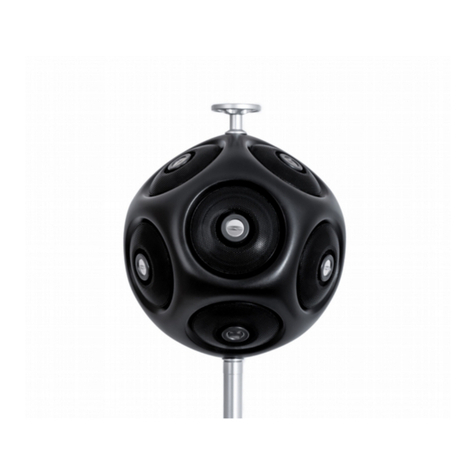Level setting:
To set the output level or signal gain,
the up and do n buttons are used,
marked ”UP” and “DOWN”. Pushing
once ill induce a 1 dB level step.
Holding do n the button ill make
the level scroll up or do n. The level
setting is indicated by red LEDs in the
display, in dB, marked ”dB”.
When 0 dB is indicated a very lo to no (zero) output signal is given. When 60 dB is in-
dicated the maximum amplification is reached. Depending on the selected signal the
amplifier may reach its maximum output voltage before reaching the 60 dB setting.
Selecting a signal:
The right led in the display ill indicate hich type of signal is active. And a letter L/A
sho s the equalization setting for Qohm.
To select a signal press the button on the top right, marked “signal”. The output signal ill
toggle bet een:
pink noise L. linear output bet een 45-20000 Hz*
pink noise A. shaped spectrum 45-16000 Hz* equalizing the source
pink noise E. shaped spectrum 45-16000 Hz, ith lo frequency tuning
hite noise L. linear output bet een 45-20000 Hz*
hite noise A. shaped spectrum 45-16000 Hz* equalizing the source
hite noise E. shaped spectrum 45--16000 Hz, ith lo frequency tuning per octave band.
external signal** L. linear output spectrum 20-20000 Hz
external signal** A. shaped spectrum 45-16000 Hz* equalizing the source
external signal E. shaped spectrum 45--20000 Hz, ith lo freq. tuning per third octave
In each case the letter for the equalization is displayed and the LED bar on the far right
ill point to the type of signal as printed next to the LED bar. The level of output
po er/noise ill vary significantly hen going from L to A and E filtering.
* The frequency range depend on the selected and pre-programmed product (sound source or other) the
sho n numbers are valid for the Qohm, Qohm2 or Qm products.
** For linear amplification the external signal is limited to 0.35 V sspk or 0.7V pk-pk.
Selecting interrupted mode:
Short depression of the mode button ill make the amplifier run in interrupted mode. It
ill put the amplifier is stand-by mode for 20s, automatically follo ed by 20s activity,
follo ed by standby, etc. To de-activate this mode just briefly push the mode button
again.
Central LED meaning:
Four red arning LEDs are located in the middle of the display.
The top one ill clearly light up hen the amplifier reaches saturation and goes into a
non-linear mode. In this mode the peak voltages are limited to a + 75V and -75V maxim-
um. It is ell possible to let the amplifier ork in this non-linear range. But it may not be
safe for the source or speaker or shaker, because the amount of electric po er going
into the speaker is increasing even if the peak voltage is limited.
The second LED do n indicates an overheating of the amplifier. This may occur after
long periods of stand-by in arm environments or hen the amplifier is covered by an
other object hampering the normal cooling. The amplifier ill restart automatically hen
www.qsources.be
Ketelwinning 38 B-3290 Diest Belgium
Copyright Qsources BVBA




























